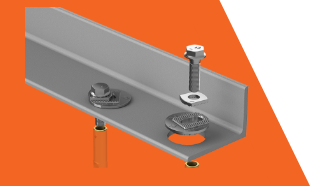“Essentially, we had two buildings to construct and then make into one,” explains Site Manager, Stephen Borsboom of Cook Brothers Construction. “One of the buildings had steel panels that were angled inwards, along with a separate angle on the roof as well. This meant we had a combination of angles to work to, which is why we decided to go with the OrbiPlate™ system.”
An additional complexity was that some of the precast panels weighed 25 tonnes, and were just over 12 metres high, making the connections even more challenging. Borsboom said the tolerances provided by the OrbiPlate™ connectors minimised the amount of rework.
The tolerance wasn’t allowed for in the design, so Borsboom says the OrbiPlate™ system changed the buildability of the project, preventing the extension of the timeline, as well as being safer, as it eliminated welding at height.
“The size of these panels in the wind was a contributing factor,” he says. “The fact that we were able to install the structural steel almost instantly and give us some stability to the building straightaway was significant.”
Cook Brothers had never used the OrbiPlate™ connectors before, so it was new to the whole team, even structural engineer Mitchell Bell, with whom they were working.
“I was introduced to them via a colleague, and then put in touch with Ramset before introducing them to the structural engineer,” explains Borsboom. “This was the first project the engineer had used them for as well.”
The project’s structural engineer, Mitchell Bell of Powell Fenwick, said that he received good feedback from the site team after working with the OrbiPlate™ connectors.
“It made life easier onsite, which makes life easier back in the office as well,” he says. “This was my first project using them. It was bit different and a change in the way I design but we got good feedback from onsite. We have already worked with them again, after a request from a different builder on another site, so we have used them twice now. They are part of the repertoire now.”
“It increased the construction tolerances a lot,” adds Borsboom. “It gave us a chance to actually get it right first time. I think on average, we had seven or eight per cent needing reworking instead of the potential for all of them to be redone.”
“We used 360 of them, which would have meant 360 individual welds on a washer if we’d gone the traditional route. And washers obviously have four sides. So that’s four times 360, which is a lot of site welding, especially at height. The time cost of that compared to using the OrbiPlate™… I don’t even know how you could measure that.”
“Without using OrbiPlate™ they would still be drilling steel.”
The new 783m2 purpose-built facility is spread over two storeys with Salvation Army operating all their services from the ground floor and associated social services out of the first floor. It’s a much-needed facility for the area and even includes a community theatre.
The Queenstown climate was another consideration during the build, with the team facing challenging weather conditions throughout, which in turns puts pressure on them to do the work as quickly as possible.
“We work year-round, says Borsboom. “We continue to work through rain, snow and ice and rain – it’s just another day. Today we’ve got torrential sideways rain, and we are expecting 30 to 40 centimeters of snow overnight.”
About OrbiPlate™
Ramset’s patented OrbiPlate system delivers orbital connection tolerances of up to 20mm in structural connections. OrbiPlate is quick and easy to install, delivering fine locational accuracy when positioning steel members.
CASE STUDY








